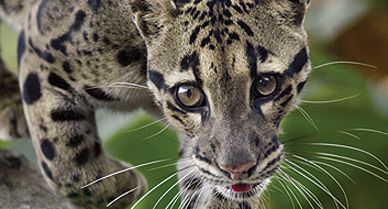Trailblazers
This month, pandas and other exotic creatures go on view at the National Zoo’s new Asia Trail
On September 20, when the spectacular new Asia Trail at the National Zoo opens, many visitors will rush right to its centerpiece, the Fujifilm Giant Panda Habitat, to see the Zoo's super-celebrity panda cub Tai Shan. But some will no doubt get waylaid watching the antics of an even younger cub, an 8-month-old sloth bear named Balawat—which means "power" in Sinhalese, a national language of Sri Lanka. There will be lots to see at the new sloth bear amphitheater, since sloth bears, despite their name, are very busy bears. Other visitors will be diverted by realistic, luxuriant habitats, some with pools and waterfalls, ideal opportunities to view clouded leopards, Japanese giant salamanders and other exotic creatures.
Asia Trail will offer state-of-the-art interactive displays with comprehensive information about an eclectic mix of fascinating Asian species as well as conservation techniques employed throughout Asia. Among those species will be animals already living at the Zoo, such as fishing cats, Asian small-clawed otters and red pandas, raccoon-like animals that were the first to be called "panda." In their new home, the sloth bears will have plenty of room to enjoy their busy lives—foraging for fruit, digging for insects, huffing and puffing with their long snouts, climbing trees and carrying cubs piggyback (the only bears to carry their young that way). Zoogoers will be able to sit in the amphitheater and watch the shaggy sloth bears use their powerful snouts to suck up snacks from an interactive feeding zone.
Asia Trail will also feature species new to the Zoo, including the endangered Japanese giant salamander, a huge—up to five feet long—creature that looks like it was imagined for a science fiction movie. The Zoo's clouded leopards have not yet been on public display; this month they will make their debut. Scientists at our Conservation and Research Center—collaborating with colleagues in Thailand—have been studying their reproductive biology. These elusive cats are highly threatened by habitat loss, demand for their attractive pelts and poaching (for use in folk medicines).
Asia Trail, including the presence of the giant pandas, is made possible by funding from Congress and generous gifts from Fujifilm and Animal Planet. It is the first step in an ambitious ten-year renovation of the National Zoo. The next project will be Elephant Trails, an innovative, expanded home for Asian elephants and a cornerstone of the Zoo's campaign to save this magnificent species.
Visitors to the Fujifilm Giant Panda Habitat will begin their adventure at the culturally themed Conservation Plaza. They will then see the pandas in their new yard, designed around the giant pandas' behavioral preferences (see article on p. 34). Visitors will even be able to observe the giant pandas up close and sometimes face to face—through a window—as humans and pandas share an artificially cooled rock. And throughout the habitat they will learn about panda science.
The new panda habitat will also highlight something critical to the future of the National Zoo—the public-private partnership between the Smithsonian Institution and Fujifilm. What started as a generous sponsorship has turned out to be so much more, as Fujifilm has supported not only the giant pandas but also the Zoo's efforts in animal care, by donating highly specialized digital medical equipment, creating award-winning educational programs and initiating the Fujifilm Curatorial Residency at the Zoo.
By being global leaders in these fields, as well as in science and sustainability, the National Zoo and Fujifilm can together make great strides toward meeting Zoo director John Berry's lofty ten-year goal: to be recognized as nothing less than the world's finest zoo.
/https://tf-cmsv2-smithsonianmag-media.s3.amazonaws.com/accounts/headshot/lawrence-small-240.jpg)



/https://tf-cmsv2-smithsonianmag-media.s3.amazonaws.com/accounts/headshot/lawrence-small-240.jpg)